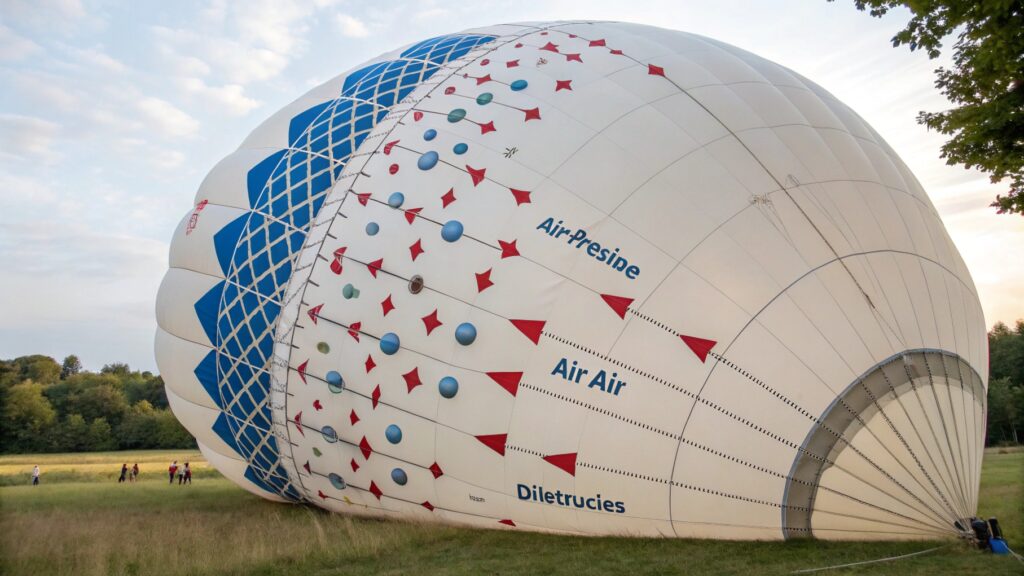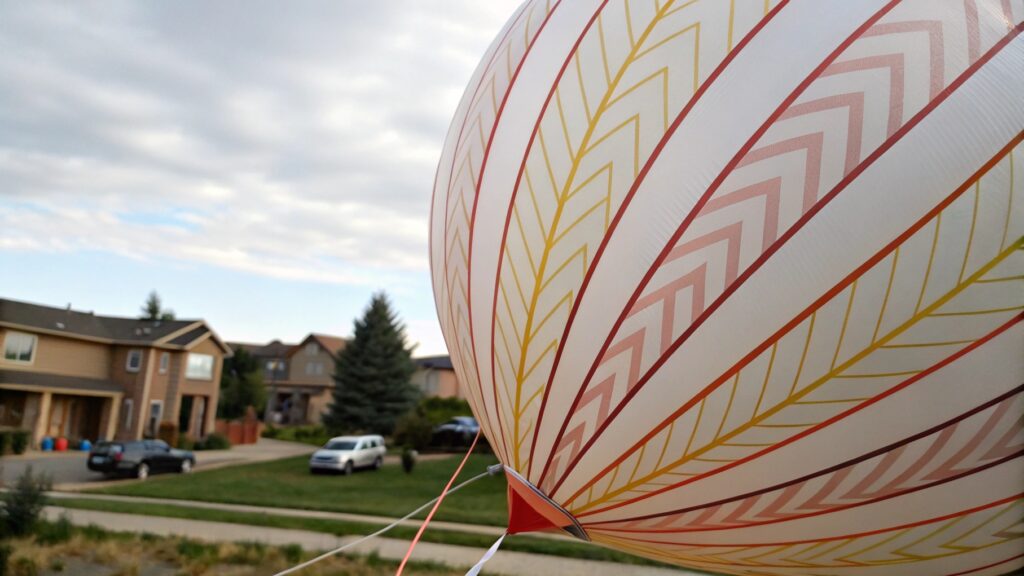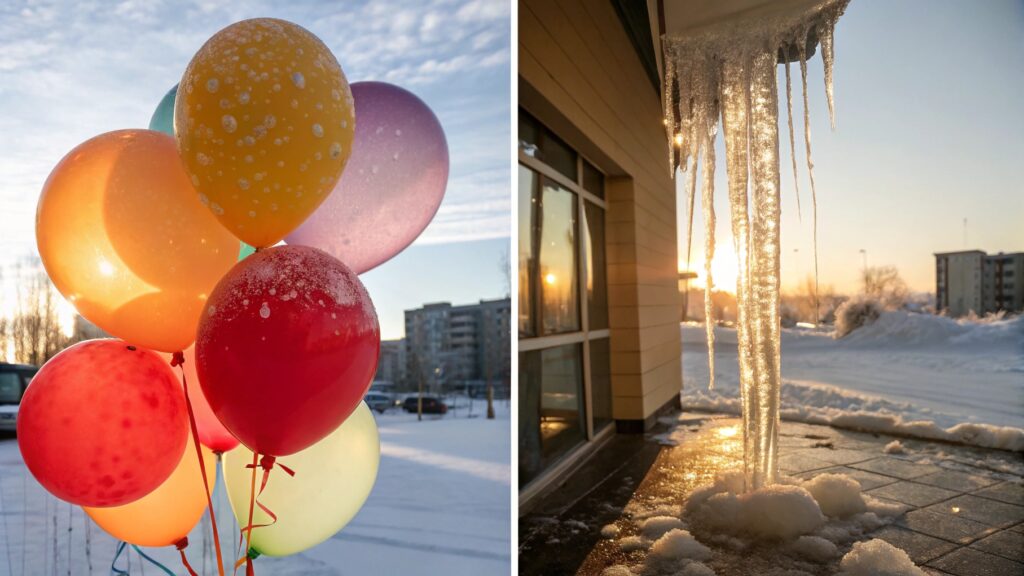What are the properties of air which twist the balloon into shapes?
Have you ever wondered how air helps us make amazing balloon shapes? It's not just about blowing; there's a real science behind it. Let's find out together.
Air pressure1 is the main force that shapes balloons. It pushes outward on the balloon's inner surface. This pressure works with the balloon material's resistance2. It allows for stretching and twisting into various designs.

As a balloon manufacturer, I've seen countless times how understanding the basics of air makes a huge difference in balloon design and durability. Let's look closer at how air works its magic.
How does air pressure affect balloon shaping?
Do you ever wonder why a balloon gets bigger when you blow into it? It's all about air pressure inside.
Air pressure inside a balloon pushes out on the material. This outward push makes the balloon expand. When you twist a balloon, you change where this pressure goes. This lets you make different shapes.

From my experience, understanding air pressure is key to making great balloon structures. It is what allows us to inflate the balloon in the first place. When we twist the balloon, we are effectively creating new compartments. The air pressure within these compartments then redistributes itself. This redistribution allows the balloon to hold its new shape. The amount of air pumped in also matters. Too much pressure can pop the balloon. Too little will not give it enough firmness to hold a twisted shape.
Key factors influenced by air pressure3:
| Factor | Description | Impact on Balloon Shaping |
|---|---|---|
| Expansion | Air molecules push against the inner surface of the balloon. | This causes the balloon to inflate and stretch. An even pressure distribution ensures a smooth, round shape before twisting begins. |
| Firmness | The internal pressure gives the balloon its rigidity. | Higher pressure makes the balloon firmer and better holds a twisted shape. Lower pressure results in a softer, less stable form. |
| Twist Holding | When a twist is formed, air is trapped in segments. The pressure in each segment helps maintain the twist. | Each segment maintains its form because of the air trapped inside at a specific pressure. If pressure drops, the twist can unravel. |
| Bursting Point | Every balloon material has a limit to how much pressure it can withstand before breaking. | Understanding this limit is important for safe inflation. Over-inflation due to excessive pressure causes the balloon to pop. This is a common issue for beginners. |
| Shape Stability | Consistent air pressure throughout the balloon's segments contributes to the stability of the final sculpture. | Uneven pressure distribution can lead to lopsided or unstable shapes. It can cause twists to come undone. |
What role does air density4 play in balloon twisting?
Have you ever considered why some balloons float and others do not? Air density has a big part in this.
Air density affects a balloon's ability to float. Regular air balloons filled with normal air will not float because regular air is heavier than the air around it. For a balloon to float, you need to fill it with a gas that is lighter than air, like helium or hydrogen. Helium is preferred because it is safer.

From my perspective in manufacturing, air density is crucial, especially when we talk about specialty balloons5. For general air-filled balloons, density is not as critical for twisting. However, if the goal is to make a sculpture that floats, like a giant balloon animal for a parade, then density becomes the most important factor. Normal air (mostly nitrogen and oxygen) is denser than hot air or gases like helium and hydrogen. That is why a hot air balloon rises. It is also why a helium balloon floats. Hydrogen is lighter than helium. But hydrogen is flammable. Helium is an inert gas. It means it does not react with other substances. This makes helium the safest choice for balloons that need to float. We always recommend helium for floating balloons.
Impact of air density on balloon behavior6:
| Property | Description | Consequence for Balloons |
|---|---|---|
| Normal Air Density | Composed mainly of nitrogen (N2) and oxygen (O2) with trace gases. Its density is about 1.225 kg/m³ at sea level and 15°C. | Balloons filled with normal air will not float. They are heavier than the surrounding air. They are good for twisting into shapes on the ground or hanging. |
| Helium Density | A noble gas, much lighter than air. Its density is approximately 0.1786 kg/m³ at standard conditions. | Helium-filled balloons float because helium is significantly less dense than air. This makes helium ideal for decorative floating balloons or large, displayable twisted sculptures. |
| Hydrogen Density | The lightest element, even less dense than helium. Its density is about 0.08988 kg/m³ at standard conditions. | Hydrogen-filled balloons float very well. However, hydrogen is highly flammable. This poses a significant safety risk. It is rarely used for commercial balloons. |
| Buoyancy | This is the upward force exerted by a fluid that opposes the weight of an immersed object. It is directly related to the density difference. | For a balloon to float, its total weight (balloon material plus gas inside) must be less than the weight of the air it displaces. This principle drives the choice of filling gas. |
| Temperature Effects | As air temperature increases, its density decreases. Conversely, as temperature decreases, density increases. | Hot air balloons demonstrate this well. Heating the air inside makes it less dense, causing the balloon to rise. For regular balloons, extreme temperature changes can cause expansion or contraction. These can affect tightness and shape. |
How does the elasticity7 of air influence balloon deformation?
Have you ever stretched a rubber band and noticed it springs back? Balloons have a similar property because of the air inside them.
The elasticity of the balloon material and the air within it work together to allow deformation. The air, although not elastic in the same way as rubber, provides constant pressure. This pressure works against the elastic limits of the balloon wall. It lets the balloon stretch and return to its original shape. When twisted, the air moves. This movement helps hold the new shape.

From a manufacturing standpoint, when we produce balloons, we consider the inherent elasticity of the latex or foil material. We also factor in how that material interacts with the contained air. Air itself is a gas. It is compressible and expandable. These are properties that allow it to fit into various volumes. When we inflate a balloon, the air molecules push against the elastic walls. This causes the balloon to expand. When you twist a balloon, you are not compressing the air into smaller spaces. You are shifting the air, creating areas of higher and lower pressure. But the total volume of air remains constant within the sealed balloon. The elastic material then "hugs" this redistributed air. This helps the balloon hold its twisted shape. If the material was not elastic, the balloon would not stretch. If the material was too elastic, it would not hold a shape. We fine-tune our materials to get the best balance for both inflation and twisting.
Elasticity and air interaction:
| Aspect | Description | Relevance to Balloon Deformation |
|---|---|---|
| Material Elasticity | The inherent property of the balloon's material (e.g., latex, foil) to return to its original shape after stretching or compression. | This is fundamental. Without elastic material, a balloon could not inflate or hold a twisted shape. The material stretches to accommodate air and then contracts around twists to secure them. |
| Air Compressibility | Air can be squeezed into a smaller volume. Its density increases as volume decreases under pressure. | While air within a balloon is under pressure, significant compression during twisting is limited by the fixed volume. Instead, air redistributes within the continuous balloon space. |
| Air Expansion | Air can expand to fill a larger volume. Its density decreases as volume increases. | As the balloon inflates, the air expands to fill the larger space. This keeps the internal pressure from becoming excessively high too quickly. |
| Pressure Equalization | Air molecules naturally try to spread out evenly to fill available space. | When you twist a balloon, you create partitions. The air inside each segment pushes outwards. This creates roughly equal pressure in each section. This helps maintain the twisted form. |
| Shape Memory | While not a direct property of air, the balloon's ability to hold a twisted shape is a combination of the material's elasticity and the trapped air's pressure. | The combined effect creates a "memory" for the intended shape. This ensures that a well-made twist does not unravel easily. This is vital for complex balloon sculptures8. |
Beyond pressure, what other air characteristics contribute to balloon sculpturing?
Have you ever thought about what else air does inside a balloon besides just pushing outwards? There's more to it.
Beyond pressure, the temperature of the air inside a balloon can affect how firm it is. Colder air makes the balloon slightly less firm because the air molecules move slower. Warmer air makes it firmer. Also, the chemical makeup of the air, whether it's normal air or a gas like helium, determines if the balloon floats. This affects how a sculpture can be displayed.

From over three decades in the balloon industry, I have seen how these subtle properties of air can make or break a balloon design. When we inflate a balloon with normal air, we are not just adding mass; we are introducing a dynamic system. For instance, air temperature plays a role. Think about how a car tire behaves in winter versus summer. Air inside the balloon behaves similarly. During cold weather, the air inside contracts, and the balloon might feel softer. In warmer weather, the air expands, and the balloon feels firmer. This change affects how easy it is to twist and how stable the final shape remains. Moreover, while air is mostly nitrogen and oxygen, introducing other gases like helium completely changes the balloon's function. While normal air allows for ground-based sculptures, helium enables breathtaking floating creations. We take all these properties into account. We do this to ensure that our balloons perform as expected, whether they are twisted, inflated, or floating.
Other contributing air characteristics:
| Characteristic | Description | Impact on Balloon Sculpturing |
|---|---|---|
| Temperature | The degree of heat present in the air. Higher temperatures increase molecular kinetic energy. Lower temperatures decrease it. | Warmer air causes slight expansion and firmness, making twists potentially easier to form but also increasing the risk of bursting if overfilled. Colder air causes contraction, making the balloon softer and possibly harder to twist. |
| Humidity | The amount of water vapor in the air. | High humidity9 can subtly affect the balloon's material. It can make it slightly softer or stickier, which might influence ease of twisting and long-term shape retention. |
| Chemical Composition of Air | The specific gases that make up the air (e.g., standard atmospheric air, helium10, hydrogen11). | This determines whether the balloon floats or not. Normal air allows for ground-based or suspended sculptures. Lighter gases such as helium (which is inert and safe) allow for floating sculptures. Hydrogen is not safe. |
| Molecular Motion | Air molecules are constantly in random motion, colliding with each other and the balloon walls. | This molecular movement creates the internal pressure. This continuous pressure maintains the form of the twisted segments. It helps the balloon hold its overall shape. |
Conclusion
Air's properties like pressure, density, temperature, and elasticity are all key to balloon twisting. They allow us to inflate, shape, and even float balloons. Understanding these helps create amazing and lasting designs.
-
Understanding air pressure is crucial for creating stable and impressive balloon designs. ↩
-
Explore how the material properties influence balloon design and durability. ↩
-
Understanding these factors can enhance your balloon twisting skills. ↩
-
Find out why some balloons float while others do not, based on air density. ↩
-
Explore the unique characteristics of specialty balloons that make them ideal for specific applications. ↩
-
Explore the various factors that affect how balloons behave in different conditions. ↩
-
Elasticity is key to how balloons maintain their shape; learn how it affects balloon design. ↩
-
Learn about the techniques that make balloon sculptures possible, enhancing your creative skills. ↩
-
Humidity can subtly influence balloon behavior; learn how to account for it in your designs. ↩
-
Learn why helium is preferred for floating balloons due to its inert properties and safety. ↩
-
Hydrogen is flammable; understanding its risks is vital for safe balloon manufacturing. ↩
